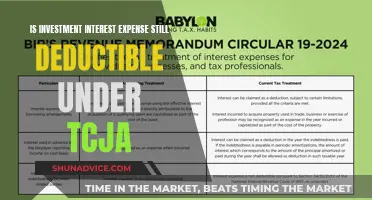
Investment interest expense deductions can be carried forward to future tax years. The amount of investment interest allowable as a deduction for the current year is limited to investment income, and is calculated on Form 4952. Any interest expense in excess of the amount allowable can be carried forward and is listed on line 7 of the form. The IRS limits the investment interest expense deduction to the taxpayer's net income from an investment.
| Characteristics | Values |
|---|---|
| Can investment interest be carried forward to future years? | Yes |
| How is this calculated? | Using Form 4952 |
| What is Form 4952? | A form used to determine the amount of investment interest expense you can deduct for the current year and the amount you can carry forward to future years |
| What is the restriction? | The investment interest expense deduction is limited to the taxpayer's net income from an investment |
What You'll Learn

Investment interest expense deductions
You can only take a deduction for investment interest expenses that is less than or equal to your net investment income. For example, if you have $3,000 in margin interest but net investment income of only $1,000, you can only deduct the $1,000 in investment interest in the current year. The IRS does allow you to carry forward the disallowed deduction into future years, however. In this example, you can use the $2,000 in disallowed expenses for this year in a future year, but the same restrictions continue to apply. You must have net investment income to deduct qualifying investment interest.
The amount of investment interest allowable as a deduction for the current year is calculated on Form 4952. Any interest expense in excess of the amount allowable can be carried forward and is listed on line 7 of the form. Form 4952 is divided into three sections: Part I consists of three lines on which you calculate your total investment interest expense; Part II is where you enter your gross income from property held for investment; and Part III serves two purposes—calculating any disallowed expense that you can carry forward to future years and determining your net investment interest expense deduction for the current year. This final amount is what you transfer to Schedule A to be used as an itemised deduction on your taxes.
Interest Rates and Investment: Inverse Relationship?
You may want to see also

Net investment income
The amount of investment interest expense that exceeds your deductible amount can be carried forward to future tax years. This is calculated on Form 4952, which is divided into three sections.
Part I consists of three lines on which you calculate your total investment interest expense. Part II is where you enter your gross income from property held for investment. After a few adjustments, you arrive at your net investment income on line 6.
Part III serves two purposes: calculating any disallowed expense that can be carried forward to future years, and determining your net investment interest expense deduction for the current year on line 8. This final amount is what you transfer to Schedule A to be used as an itemised deduction on your taxes.
You can only take a deduction for investment interest expenses that is less than or equal to your net investment income. For example, if you have $3,000 in margin interest but net investment income of only $1,000, you can only deduct the $1,000 in investment interest in the current year. The IRS does allow you to carry forward the disallowed deduction into future years, however. In this example, you can use the $2,000 in disallowed expenses for this year in a future year, but the same restrictions continue to apply. You must have net investment income to deduct qualifying investment interest.
Understanding Investment Interest Expense: What Investors Need to Know
You may want to see also

Disallowed expenses
Investment interest expense deductions are calculated on Form 4952. The amount of investment interest allowable as a deduction for the current year is limited to net investment income. Any interest expense in excess of the amount allowable can be carried forward to future years and is listed on line 7 of the form.
The IRS does allow you to carry forward disallowed deductions into future years. For example, if you have $3,000 in margin interest but net investment income of only $1,000, you can only deduct the $1,000 in investment interest in the current year. You can use the $2,000 in disallowed expenses for this year in a future year, but the same restrictions continue to apply.
The final figure from Part III of Form 4952 is transferred to line 9 of Schedule A. The IRS limits the investment interest expense deduction to the taxpayer's net income from an investment. According to the IRS, the following instances serve as exceptions to filing the form: if the investment interest expense is less than your investment income from interest and ordinary dividends minus any qualified dividends, or if you don't have any other deductible investment expense.
Acorn Investments: Interest Payments and Your Money
You may want to see also

Form 4952
Yes, investment interest can be carried forward to future years.
You must file Form 4952 to claim a deduction for your investment interest expense on your tax return. You must offset investment expense against net investment income for a given tax year. Net investment income comprises several categories of revenue generated from investments, including interest, dividends, capital gains, rental and royalty income, and other types of investment-related income. You can only deduct investment interest expenses up to the amount of your net investment income. If investment expense exceeds net investment income, the balance is carried forward to the following year. However, the same restrictions will apply.
If you borrow money to purchase an investment, you may qualify for a tax break. The IRS allows certain taxpayers to take a tax deduction for the interest expense on some loans using Form 4952. However, the tax ramifications of investment interest can be complicated, as the IRS only allows a deduction for certain types of investment interest. The AMT is a separate tax system that limits certain tax benefits, including deducting investment interest expenses. Taxpayers subject to the AMT must calculate their tax liability using the regular and the AMT systems and pay the higher amounts. Investment interest expenses are one of the deductions disallowed under the AMT.
Compounding Interest: Investment Products to Earn More
You may want to see also

Schedule A
The amount of investment interest expense that exceeds your deductible amount can be carried forward to future tax years. This is calculated on Form 4952, which is divided into three sections. Part I consists of three lines on which you calculate your total investment interest expense. Part II is where you enter your gross income from property held for investment; after a few adjustments, you arrive at your net investment income. Part III serves two purposes: calculating any disallowed expense that you can carry forward to future years and determining your net investment interest expense deduction for the current year. This final amount is what you transfer to Schedule A to be used as an itemised deduction on your taxes.
Form 4952 is used to determine the amount of investment interest expense you can deduct for the current year and the amount you can carry forward to future years. Your investment interest expense deduction is limited to your net investment income. If you borrow money to purchase property you hold for investment, the interest paid is investment interest. However, if you borrow money for business or personal use as well as for investment, you must allocate the debt among those instances. Only the interest expense on the part of the debt used for investment purposes can be treated as investment interest.
The amount of investment interest allowable as a deduction for the current year is limited to investment income. Any interest expense in excess of the amount allowable can be carried forward and is listed on line 7 of Form 4952. The final figure from Part III is transferred to line 9 of Schedule A. The IRS limits the investment interest expense deduction to the taxpayer's net income from an investment.
Investment Interest Expense: What Can Be Deducted?
You may want to see also
Frequently asked questions
Yes, you can carry forward investment interest to future years.
You can only take a deduction for investment interest expenses that is less than or equal to your net investment income. For example, if you have $3,000 in margin interest but net investment income of only $1,000, you can only deduct the $1,000 in investment interest in the current year. The IRS does allow you to carry forward the disallowed deduction into future years.
You can record the amount of investment interest you want to carry forward on Form 4952.







